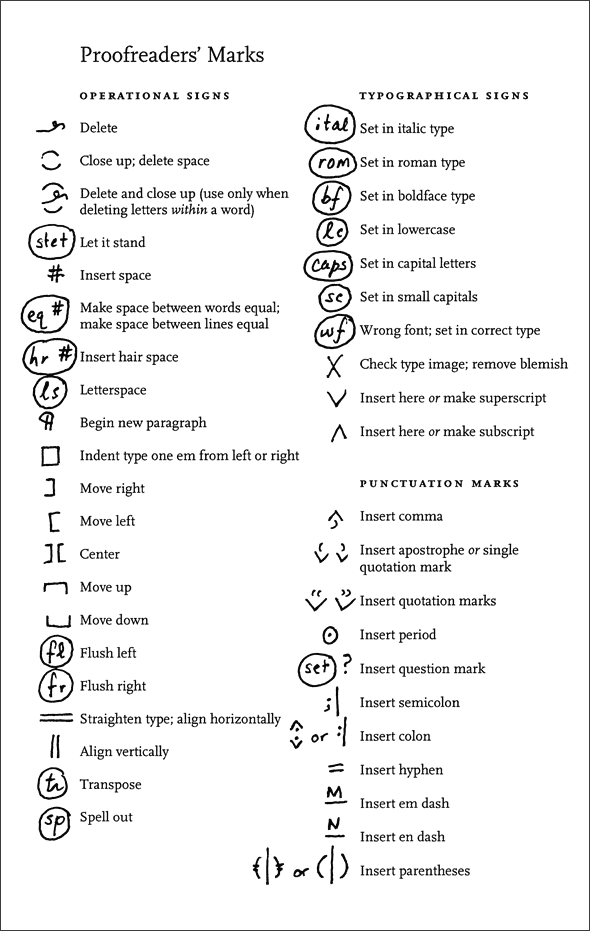Although most editing and proofreading are performed today using the ‘Track Changes’ feature of Microsoft Word or other commenting tools, you may encounter traditional proofreading marks and symbols on a hardcopy document. In desktop publishing, it is important to understand the meaning of proofreaders’ marks. Both editors/proofreaders and clients, regardless of their backgrounds, should have the same standard marks for easy communication.

Although most editing and proofreading are performed today using the ''Track-Changes'' feature of Microsoft Word or other commenting tools, you may encounter traditional proofreading marks and symbols on a hardcopy document. In desktop publishing, it is important to understand the meaning of proofreaders’ marks. Both editors, proofreaders, and clients, regardless of their backgrounds, should have the same standard marks for easy communication. That is why a consistent style and common proofreading marks and symbols should be used. These marks and symbols are considered the language that editors and proofreaders speak when they edit or proofread a hardcopy document.
As we discussed in the ‘‘The Difference Between Proofreading and Editing’’ article, the purpose of proofreading is to correct all errors in grammar, punctuation, syntax, and spelling in a manuscript. To confirm whether the final version of one’s manuscript contains any minor errors, you need proofreading. However, editing requires extra effort from an editor than does proofreading, because editing aims to improve the academic quality of your paper. Thus, editing involves improvement of the content, overall structure, quality of findings and analysis, simplicity, and referencing of the paper. Editing also aims to correct all errors in grammar, typography, punctuation, syntax, and spelling in a manuscript. In this sense, editing encompasses proofreading; however, strictly speaking, proofreading is the last stage before printing or delivery to the client. In hardcopy proofreading, editors and proofreaders use specific proofreaders’ marks to communicate their revisions.
If you have ever had a hardcopy paper proofread, you are probably familiar with the unexpected typology of your proofreader. The revised version of your document is returned with symbols that seem to be from a different language.
In a revised hardcopy version of a paper, all edits are visibly marked, including corrections, suggestions, and comments. These strange symbols and marks, left by proofreaders to highlight where changes need to be made in the text, allow you to notice all corrections and suggestions.
Proofreaders’ marks (also known as proofreading marks) are symbols and abbreviations for correcting typeset pages. The editors and proofreaders place these marks in the margins and in corresponding lines of text. These symbols and marks referring to comments about and suggestions for revisions appear in the margins and text of your manuscript.
In hardcopy proofreading, corrections and suggestions typically appear in the left or right margins, beside the line containing the error. A mark or symbol is also placed in the text to indicate where corrections and changes need to be made. A caret (^), for instance, indicates an addition, whereas a line through the text indicates a deletion or replacement. Proofreading marks are generally written in red ink for the best visibility.
Here is a list of the most common proofreaders’ marks for your reference (the list is taken from The Chicago Manual of Style Online):

(Source: The Chicago Manual of Style Online)
As discussed above, a revised version of a document, full of strange symbols and abbreviations, may seem to have been translated into another language. Understanding this strange language or decrypting the suggested changes might take hours and maybe time-consuming and challenging. It does not have to be anymore, thanks to the ''Track Changes'' function of Microsoft Word. The ''Track Changes'' function in Microsoft Word is a very handy tool for tracking all changes, corrections, edits, and even suggestions and comments by your editor or proofreader.
With this function, your document is returned with all edits visibly marked. All of the edits, including corrections, suggestions, and comments, via the ‘Track Changes’ function, appear in the margins of a revised paper. It is very easy to notice, follow, accept, or reject all the changes and suggestions in the paper. With a tracked paper, you also see some essential comments by the editor or proofreader on the right-hand side of the page. To read more about the ‘Track Changes’ function in Microsoft Word, click here.
Best Edit & Proof expert editors aim to provide your manuscripts with proper scholarly and academic tone and style. They will significantly improve the chances of having your research manuscript accepted for publishing. They provide subject-area proofreading and editing services in several fields categorized under various disciplines. With our extensive knowledge and expertise, we will help you find the right tone and style for your manuscript.
If you need our subject-area editors to format your manuscripts, giving you the fundamental rules for formatting your manuscripts as described in your guidelines, such as APA, MLA, or Chicago/Turabian styles, then contact us. At Best Edit & Proof, our proofreaders and editors edit every type of academic paper. We have a user-friendly website and a simplified ordering process.
If you would like our subject-area editors and language experts to work on your project for the improvement of its academic tone and style, then please visit the order page. It is easy! It takes only a few minutes to submit your paper and complete the process. Click here to see how it works.

We have flat-rate pricing based on our type of service (editing or proofreading), word count, and turnaround time. Enter your word count or copy and paste your document into our pricing calculator to get an instant quote.
If you need support for editing and proofreading services, contact us. You can also e-mail us or use the 24/7 live chat module to get direct support. We have a 24/7 active live chat mode to offer you direct support along with qualified editors to refine and furbish your manuscript. Alternatively, you can text us through our WhatsApp business line.
Follow us on Twitter, LinkedIn, Facebook, Instagram, and Medium.
For more posts, click here.
This article discusses proofreaders’ marks (proofreading marks) and symbols. To give you an opportunity to practice proofreading, we have left a few spelling, punctuation, or grammatical errors in the text. See if you can spot them! If you spot the errors correctly, you will be entitled to a 10% discount.
How Much Do Professional Editing and Proofreading Cost?
01.02.2022
How Much Do Proofreading and Editing Cost?
19.06.2021
How to Choose a Dissertation Editor in 3 Steps
23.05.2022
8 Proofreading Tips: Everything to Understand the Process
30.04.2022
Dissertation Proofreading: Four Easy-to-Follow Steps
28.04.2022

When you start with academic writing, it is easy to confuse editing and proofreading. Each service requires close and careful reading but uses different methods and focuses on different aspects of the manuscript. Both services produce different outcomes for writers, and therefore, our potential clients must be aware of what they do. As a beginner, you may make the same common mistake as the rest, but we are here to help things set straight. In this article, we will learn the exact meaning behind these two concepts, what they are, and how they are different from each other.
Continue Reading
Proofreading is one of the basic procedures carried out on a text to render it flawless. This procedure requires extensive knowledge and comprehension to correct a manuscript excellently. Proofreading is of importance when you need your document to be checked for errors in grammar, punctuation, syntax, spelling, and formatting.
Continue Reading
Researchers who are not native speakers of English are mostly confronted with some challenges in getting their papers published. This is probably why the editing and proofreading business has flourished in the field of academics over the past decade. Still, this business is inefficiently controlled and is often extremely problematic. The quality of the services is extremely uneven, and target groups of the editing services (e.g., clients, peer-reviewed journals, institutions, and readers) may be shackled by several fallacies. To deal with them, we discuss some myths about academic editing and proofreading services.
Continue Reading
For academic achievement, staying ahead of the pack is always a crucial issue. Taking advantage of professional academic editing and proofreading can help you reach your potential and increase chances of your work being published in professional journals. It requires a broad-ranging comprehension to fix a document exceptionally. Therefore, academic editing and proofreading are a critical part of the writing process.
Continue Reading
Proofreading a dissertation differs from dissertation editing in the aspect that it does not drastically change the composition of the manuscript. The fundamental purpose of dissertation proofreading is to enhance a document's linguistic clarity and formatting. And as such, the amount of time required to proofread is lower than that needed to edit a dissertation. It is an integral part of the dissertation submission process that ensures a manuscript's overall veracity. But, owing to its low turnaround time and seemingly lackluster objective, many academics do not prioritize proofreading adequately.
Continue Reading